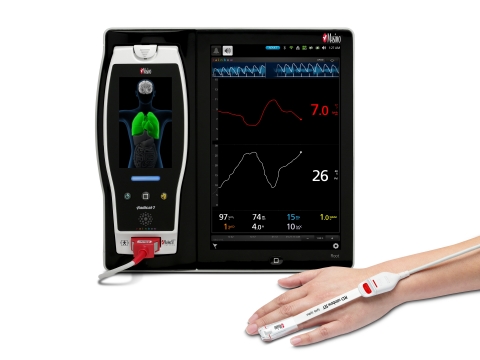New Study Associates Masimo SpHb®, Noninvasive and Continuous Hemoglobin Monitoring, as Part of Pediatric Patient Blood Management, with Reduced ICU Stays and Postoperative Transfusion

Masimo Root® with SpHb® (Photo: Business Wire)
Neuchatel, Switzerland:
Masimo (NASDAQ: MASI) announced today the findings of an abstract recently presented at Euroanaesthesia 2020 in which Dr. Saraçoğlu and colleagues at Marmara University in Istanbul, Turkey investigated the efficacy of Masimo noninvasive and continuous hemoglobin monitoring, SpHb®, as part of the transfusion management of pediatric patients undergoing major surgery.1 The researchers found that use of SpHb was associated with decreased rate of postoperative transfusion, reduced length of ICU stay, and other improved outcomes.
Noting that traditional methods of measuring hemoglobin and estimating blood loss as part of perioperative blood transfusion management are “time consuming” and may cause delays in decision making, the researchers sought to investigate whether use of a noninvasive, continuous method, Masimo SpHb, would have an impact on transfusion rates, morbidity, and mortality in pediatric patients undergoing craniosynostosis surgery. Pediatric patients aged 2-24 months were divided into a control group (n = 28), whose transfusion therapy was managed using intermittent blood gas analysis, and an experimental group (n = 27), whose transfusion therapy was managed using SpHb monitored with Masimo rainbow® sensors connected to a Radical-7® Pulse CO-Oximeter®. In both groups, blood gas analysis was performed hourly during the perioperative period; in the SpHb group, when SpHb monitoring indicated a sudden decrease in hemoglobin, blood gas analysis was simultaneously performed.
The researchers calculated the following statistically significant (p < 0.05) results:
| Outcome | Control Group | SpHb Group | P-value |
| Length of stay in ICU | 55.43 hours ± 25.34 hours (48 hours median) | 33.48 hours ± 12.25 hours (24 hours median) | 0.001 |
| Postoperative drainage | 215.54 mL ± 93.1 mL | 136.85 mL ± 62.27 mL | 0.001 |
| Postoperative red blood cell transfusion | 179.02 mL ± 163.06 mL (145 mL) | 102.69 mL ± 73.87 mL (105 mL) | 0.033 |
| Postoperative fresh frozen plasma transfusion | 71.96 mL ± 94.95 mL (25 mL) | 28.15 mL ± 64.35 mL (0 mL) | 0.043 |
| Perioperative crystalloid | 396.79 mL ± 171.16 mL (350 mL) | 462.59 mL ± 158.91 mL (500 mL) | 0.048 |
| First platelet level in ICU | 270,821 ± 74,474 | 327,185 ± 104,644 | 0.025 |
| Last lactate level in ICU | 1.47 mmol/L ± 0.64 mmol/L (1.25 mmol/L) | 1.18 mmol/L ± 0.63 mmol/L (0.9 mmol/L) | 0.044 |
They found that the length of stay in the ICU was statistically significantly higher in the control group than the SpHb group. Postoperative drainage, red blood cell transfusion, and fresh frozen plasma transfusion in the ICU were also statistically significantly higher in the control group than the SpHb group. Lactate levels were higher in the SpHb group at the start of the operation, but higher in the control group at the end.
The researchers concluded, “Noninvasive continuous hemoglobin monitoring in major hemorrhagic surgeries in pediatric patients might be effective in reducing morbidity not only by reducing the amount of transfusion but also [by] leading to less metabolic and hemodynamic instability.”
In other clinical studies, conducted with adult patients, continuous monitoring with SpHb as part of patient blood management (PBM) programs has been found to improve outcomes, such as reducing the percentage of patients receiving transfusions,2 reducing the units of red blood cells transfused per patient,3-4 reducing the time to transfusion,5 reducing costs,6 and even reducing mortality 30 and 90 days after surgery by 33% and 29%, respectively.7 The evidence of SpHb’s impact on outcomes spans the globe, representing 6 countries on 4 different continents.2-8 Today, SpHb technology supports clinicians in over 75 countries around the world.9
SpHb is not intended to replace laboratory blood testing. Clinical decisions regarding red blood cell transfusions should be based on the clinician’s judgment considering, among other factors, patient condition, continuous SpHb monitoring, and laboratory diagnostic tests using blood samples.
Disclaimer: This content is distributed by Business Wire India.


